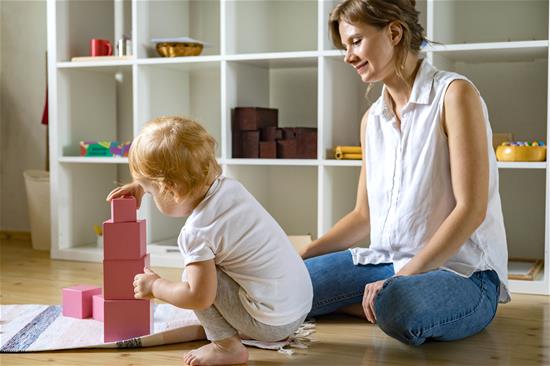- 855.471.2589
- Schedule a Tour

To anyone not familiar with Montessori education, the Pink Tower may just look like a simple block-stacking activity. However, this thoughtful learning experience offers principles of mathematics and geometry. A child first discovers it on a sensorial level, meeting their need to explore, experience, and classify all the many impressions offered by this enchanting tower. With time, it becomes more of a launching pad for abstract thought processes.
The Pink Tower is regarded as a visual symbol of an authentic Montessori education.
Most often made of wood, the Pink Tower consists of ten cubes ranging from 1 cm³ to 1000 cm³. Each cube, in every set, is constructed identically. Each face has the same texture and they’re all painted pink. The only difference between cubes is their size, which isolates the challenge for a child when inspecting and stacking them. Because all the cubes are the same texture and color, a child can focus only on the varying sizes.
So, why Pink? It was certainly not a random color choice! Founder Maria Montessori is said to have experimented with many different colors, with pink being the most frequently chosen by children she worked with.
When children work with the Pink Tower, they practice and refine several skills:
- Hand-eye coordination
- Fine-motor movements
- Haptic perception – literally meaning the ability “to grasp something”
- Visual discrimination of dimensionality – the ability to identify differences in each cube's length, width, and height
“There is nothing in the intellect which is not first in the senses.”
~Aristotle
The main exercise of building the Pink Tower begins with the largest cube at the base. Then, children stack the smaller cubes until the one-centimeter cube is placed on top. There are many extensions of this exercise, such as laying the cubes out in a linear or spiral fashion and comparing the dimensions of the cubes with other materials in the classroom.
While stacking and arranging blocks may seem like a relatively basic task, the skills developed while working with the Pink Tower are myriad and can help prepare children for many future lessons, including:
- Writing – the tripod grip is practiced when carrying the small cubes
- Vocabulary – using descriptors such as small, smaller, smallest, big, bigger, biggest
- Math – comparing size variations and recognizing relationships with other classroom objects
- Concentration – the opportunity to observe, manipulate, and take keen interest for an extended period of time
- Precision – experimenting, developing a hypothesis, drawing conclusions, and taking action (work with the Pink Tower is actually engaging with the scientific method!)
“The senses, being explorers of the world, open the way to knowledge… the number of different objects in the world is infinite, while the qualities they possess are limited. These qualities are therefore like the letters of the alphabet which can make up an indefinite number of words.
If we present the children with objects exhibiting each of these qualities separately, this is like giving them an alphabet for their explorations, a key to the doors of knowledge… This ‘alphabet’ of the outer world has an incalculable value…
Everything depends on being able to see and on taking an interest.”
~Dr. Maria Montessori, The Absorbent Mind
